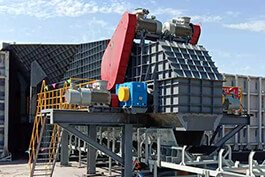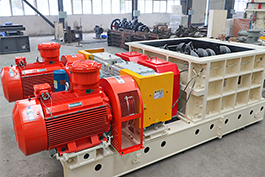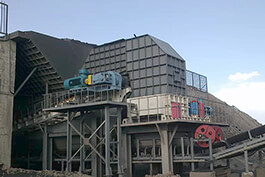Introduction
When constructing production lines in fields such as mining, cement, metallurgy or construction waste treatment, there are various options for feeders. Among them, Apron feeder, Scraper feeder and Feeder breaker are commonly used equipment, but they have significant differences in functions, structures and application scenarios. This article will analyze the distinctions among Apron feeder, scraper feeder and Feeder breaker from multiple aspects.
Feeder Breaker
Definition
The feeder breaker consists of two modules: conveying and crushing. It can complete pre-sieving while conveying the materials. The conveying part enters the crushing module to conduct preliminary crushing of the materials. It is a device that integrates feeding and crushing.
Components
Conveying carrier: The mainstream types are chain plate or counterweight plate structures. The chain plate type has strong carrying capacity and is suitable for large pieces and high-hardness materials (such as ores, construction waste blocks); the counterweight plate type maintains stability through its own weight and is suitable for medium-sized particle materials.
Conveying drive unit: It consists of a motor, reducer, and transmission sprocket, providing power to the conveying carrier and allowing the feed speed to be controlled by adjusting the motor speed to avoid overload of the crushing module.
Pre-sieving component: Some models add roller shaft or grid type screening structures on the conveying path, which can separate fine materials (such as soil, sand, and stones) from the materials in advance, reducing the ineffective operation of the crushing module and improving efficiency.
Crushing components: They are mainly divided into hammer type and roller type. The hammer type crushing components rely on the high-speed rotating hammer head to impact the materials, causing them to break, suitable for breaking medium-hard and brittle materials; the roller type crushing components use two rotating rollers to squeeze the materials to achieve crushing, more suitable for handling viscous materials or situations where the output particle size needs to be controlled.
Frame and base: It adopts a steel structure welded structure, providing stable support for all modules, and the bottom of the base usually has fixed holes, which can be connected to ground embedded parts to prevent the equipment from vibrating and shifting during operation.
.jpg)
Apron Feeder
Definition
An Apron feeder is a specialized feeding equipment that uses a looping crawler-type chain plate as the bearing and conveying component. It continuously and uniformly conveys blocky, granular, and other medium-hard materials from the storage device (such as a bin or hopper) to the subsequent equipment.
Components
Drive unit: Composed of a motor, reducer, coupling, and driving sprocket, it serves as the power source. By adjusting the motor speed, the running speed of the chain plate can be controlled, thereby adjusting the feeding volume.
Chain plate assembly: Consists of metal chain plates (usually formed by sheet metal stamping), chains, and pin shafts, it is the core component for bearing the materials. The chain plates are connected by chains, forming a continuous "conveying surface" that can withstand the impact of large pieces of materials.
Frame and guide rails: The frame provides overall support for the equipment, and the guide rails are fixed on the frame to guide the movement trajectory of the chain plate and ensure that the chain plate moves smoothly and continuously in a fixed direction, avoiding deviation.
Tensioning device: Mostly adopts a spiral tensioning or heavy weight tensioning structure, used to adjust the tightness of the chain to prevent the chain from slackening and slipping, ensuring the effective transmission of the conveying power.
Feeding and discharging devices: The feeding device is used to guide the materials precisely onto the chain plate, avoiding spillage; the discharging end uses the chain plate to turn, allowing the materials to naturally fall to the subsequent equipment.
(2).jpg)
Scraper Feeders
Definition
A Scraper feeder is a device that uses the linkage between a scraper and a chain (or steel wire rope) to achieve continuous material transportation and quantitative feeding within a trough (or specific channel).
Components
Drive unit: Composed of a motor, reducer, coupling, etc., it is the power source of the equipment, providing power for the movement of the chain and the scraper. The speed can be adjusted to control the conveying speed.
Scraper and chain: The scraper is usually made of metal (such as steel plate), fixed on the chain to form a scraper chain; the chain drives the scraper to move cyclically within the trough, directly contacting and pushing the materials forward.
Trough: As the material's bearing and transportation channel, it is divided into open type and closed type; the closed type can prevent dust leakage and is suitable for powdery materials, while the open type is convenient for maintenance.
Tensioning device: Used to adjust the tension of the chain to avoid slack causing the scraper to slip, ensuring the stable operation of the scraper chain. Common forms include spiral tensioning and weight tensioning, etc.
Comparison Between Feeder Breaker Scraper Feeders And Apron Feeders
Function Comparison
The Feeder breaker is the most comprehensive in function. It not only has the ability to convey materials but also can perform preliminary crushing of materials during the conveying process. At the same time, through the pre-sieving component, fine materials can be separated in advance, greatly improving production efficiency and reducing the workload of subsequent crushing processes. It is particularly suitable for production lines that have crushing requirements for materials and need to improve overall production efficiency.
The main function of Apron feeder is to continuously and uniformly transport medium and high-hardness materials to the subsequent equipment, with a focus on stable feeding to ensure a continuous and steady material supply for the production line. The conveying process has very little effect on material crushing, and it mainly performs material transfer functions.
The function of Scraper feeder is mainly focused on the continuous transportation and quantitative feeding of materials. Through the linkage of scrapers and chains, it can precisely control the amount of material conveyed in the trough, suitable for production scenarios that require precise control of the feeding amount, such as chemical raw material ratio feeding. It also does not have a crushing function.
Structural Differences
The structure of Feeder breaker includes two modules: conveying and crushing. The conveying carriers include chain plate type and counterweight plate type. The conveying drive unit provides power for the conveying, and the pre-sieving component is its characteristic structure, which can separate fine materials in advance. The hammer and roller designs of the crushing components are tailored to different material characteristics. The frame and base provide stable support for the entire equipment.
The core structure of Apron feeder is the cyclic moving belt-type chain plate. The metal chain plates, chains, and pin shafts of the chain plate component constitute the key part for carrying materials. The frame and guide rails provide support and guidance for the chain plate movement, and the tensioning device ensures the appropriate tension of the chain. The feeding and discharging devices ensure the accurate conveyance of materials.
The structure of Scraper feeder is key in the combination of scrapers and chains. The scraper is fixed on the chain to form a scraper chain, which moves cyclically in the trough to push the materials. The open or closed design of the trough is selected based on the characteristics of the materials. The tensioning device adjusts the tension of the chain to ensure the stable operation of the scraper chain.
Application Field Differences
Feeder breaker is mainly used in mining, construction waste treatment, and sand and gravel production. In mining, it can perform preliminary crushing and screening of the mined ore. In construction waste treatment, it can perform crushing to recycle and utilize the construction waste. In sand and gravel production, it can improve production efficiency and reduce the workload of subsequent crushing processes.
Apron feeder is widely used in mining, cement, metallurgy, and other industries. In these industries' production lines, stable and continuous transportation of medium and high-hardness block-like and granular materials, such as ores and cement clinker, is required to provide a stable material supply for subsequent crushing, grinding, etc. processes.
Scraper feeder is often used in coal, chemical, and grain industries. In the coal industry, it can be used for coal transportation and quantitative feeding. In the chemical industry, it is suitable for the transportation of various powdered and granular chemical raw materials. In the grain industry, it can be used for material transportation in the storage and processing processes of grains. It is especially suitable for scenarios with precise requirements for feeding amounts.
Conclusion
The Apron feeder, Scraper feeder and Feeder breaker are all commonly used equipment in industries such as mining, cement, and metallurgy. However, they differ significantly in terms of functions, structures and application scenarios. Therefore, when choosing a feeding equipment, one should consider the specific production requirements and material characteristics, as well as the performance, structure and application scenarios of the equipment, in order to select the most suitable one, thus ensuring the stable operation and efficient production of the production line.


.jpg)
(2).jpg)



.jpg)






